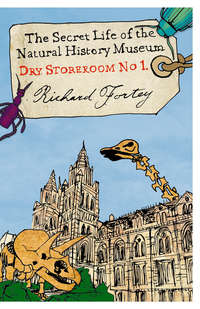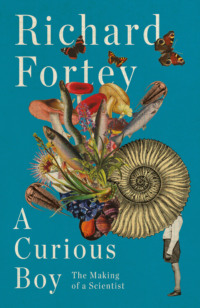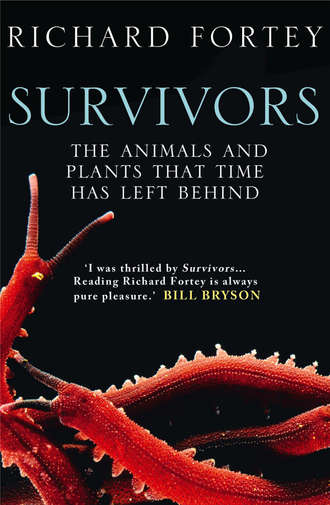
Полная версия
Survivors: The Animals and Plants that Time has Left Behind

Survivors
The Animals and Plants That Time Has Left Behind
Richard Fortey


Dedication
To my sister, with love
Contents
Cover
Title Page
Dedication
Prologue
Table of Geological Periods
1 Old Horseshoes
2 The Search for the Velvet Worm
3 Slimy Mounds
4 Life in Hot Water
5 An Inveterate Bunch
6 Greenery
7 Of Fishes and Hellbenders
8 Heat in the Blood
9 Islands, Ice
10 Survivors Against the Odds
Epilogue
Picture Section
Glossary
Picture Credits
Further Reading
Searchable Terms
Acknowledgements
Endpaper
Other Books by Richard Fortey
Copyright
About the Publisher
PROLOGUE
These anomalous forms may almost be called living fossils; they have endured to the present day, from having inhabited a confined area, and from having thus been exposed to less severe competition.
CHARLES DARWIN, The Origin of Species
Evolution has not obliterated its tracks as more advanced animals and plants have appeared through geological time. There are, scattered over the globe, organisms and ecologies which still survive from earlier times. These speak to us of seminal events in the history of life. They range from humble algal mats to hardy musk oxen that linger on in the tundra as last vestiges of the Ice Age. The history of life can be approached through the fossil record; a narrative of forms that have vanished from the earth. But it can also be understood through its survivors, the animals and plants that time has left behind. My intention is to visit these organisms in the field, to take the reader on a journey to the exotic, or even everyday, places where they live. There will be landscapes to evoke, boulders to turn over, seas to paddle in. I shall describe the animals and plants in their natural habitat, and explain why they are important in understanding pivotal points in evolutionary history. So it will be a journey through time, as well as around the globe.
I have always thought of myself as a naturalist first, and a palaeontologist second, although I cannot deny that I have spent most of my life looking at thoroughly dead creatures. This book is something of a departure for me, with the focus switched to living organisms that help reveal the tree of life (see endpapers). I will frequently return to considering fossils to show how my chosen creatures root back into ancient times. I have also broken my usual rules of narrative. The logical place to start is at the beginning, which in this case would mean with the oldest and most primitive organisms. Or I could start with the present and work backwards, as in Richard Dawkins’ The Ancestor’s Tale. Instead, I have opted to start somewhere in the middle. This is not perversity on my part. It seemed appropriate to start my exploration in a place, biologically speaking, that is familiar to me. The ancient horseshoe crabs of Delaware Bay were somehow fitting, not least on account of their trilobite connections. Amid all the concern about climate change and extinction, it is encouraging to begin with an organism whose populations can still be counted in their millions. From this starting point somewhere inside the great and spreading tree of life I can climb upwards to higher twigs if I wish, or maybe even delve downwards to find the trunk. Let us begin to explore.
TABLE OF GEOLOGICAL PERIODS
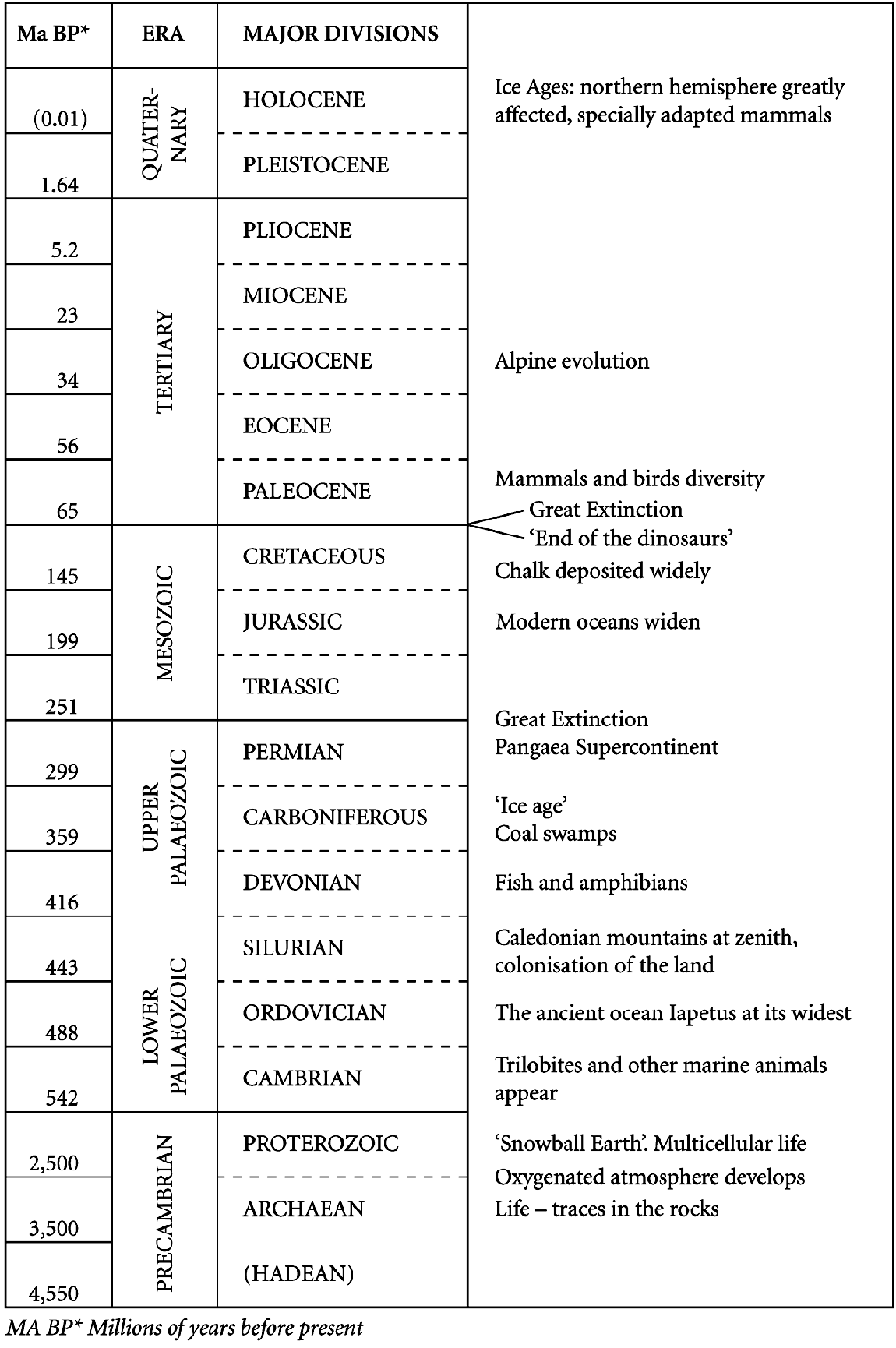
1

Old Horseshoes

Turn seawards off Route 1, Delaware, and a century rolls away. A small road soon leaves the commercial strip and the fast food joints behind, as it moves onto flat fields and marshland that still supports scattered, pretty villages lined with white-painted picket fences. This is how much of America’s east coast used to be. The Little Creek Inn is a grander building altogether: a large, foursquare, wooden Victorian farmstead on three floors with shutters at the windows and a fine portico, and inside all polished wood and turned banisters. In the spacious drawing room of the Inn, anticipation is buzzing. The hosts, Bob and Carol Thomas, are serving iced tea to a crew of enthusiasts all dedicated to travelling back much further in time than a mere century or so. This is the chance to come face to face with life as it was millions of years ago. Glenn Gauvry, the local expert, is waving around models of an ancient animal. A small TV crew is there to straighten out their facts before they get down to filming. Two young women biologists have travelled from Canada to see for themselves an event that only happens when the conditions are just right in late May. I am there with my notebook and a fluttering heart. All of us are impatient for darkness to fall.
Deep in the night along the shores of Delaware Bay the horseshoe crabs are stirring. The tide is now high and there is no moon. Darkness rules, but even in the feeble starlight the overwhelming flatness of the countryside can be made out, except along the rim of the bay where old sand dunes have built up a levee providing foundations for a scattering of wooden beach houses, which loom against the night sky. A path passes between them onto a sandy beach that stretches away into the darkness in a long gentle arc. The shoreline seems to heave with gentle movements.
First, I notice some very odd sounds. There is a general hollow clattering, a tapping and grinding sound, somewhat like that made by knocking coconut shells together (once used on the radio to imitate horses’ hooves) but altogether less rhythmic, and with a kind of underlying push. Then, as my eyes get used to the darkness, low shelly mounds the size of inverted colanders can be seen slowly pushing and jostling all along the shore and perhaps six metres up onto the sands. Their bumping and clambering together is the source of those tap-tapping percussive sounds. The flash of an infrared torch reveals more details. The head-shield of the horseshoe crab is domed upwards and carries a few weak spines; at its back end a hinge marks a jointed boundary with a second large plate, spiny at the edge, which can flap downwards; and beyond that again projects a stout triangular spike as long as the head, which can waggle up and down. Here at Kitt’s Hummock more crabs are gathered on the mud flats seaward of the sands waiting their turn: strange, green-black, slowly animated lumps. Further offshore again in the shallow seawater tail spikes project briefly above the gentle waves like raised radio antennae and are gone, showing where still more horseshoe crabs vie with one another to get their place on the sand. There are evidently thousands upon thousands of these large animals gathered together in some sort of compulsive collusion.
One horseshoe crab lies upturned on the sand. Its tail spike waggles feebly, quite unable to perform the task of turning the body back over again. Five pairs of legs twitch ineffectually in a vain attempt to achieve the same end. I find it impossible to resist the temptation to right the poor animal. It is easy to grasp it by the edges of the head-shield. Once righted again those spindly legs allow the crab to trundle slowly away. Its behaviour seems at once strangely determined, but also apparently random, like the slow progress of a confused old lady on a Zimmer frame.
Now I see that many of the largest crabs are digging in the sand, their limbs working away beneath the carapace. Some have become almost completely buried, and, although I can detect a kind of deep scrabbling from these animals, they do not seem to be worried by their self-inflicted interment. Other slightly smaller crabs crowd on top of the buried animals. The scrabblers are the females of the species burying their eggs in the sand, while the smaller ones on top are males, competing to fertilise the eggs with their sperm (milt). I realise that there is some kind of order to the apparent mayhem on the beach. A proportion of the horseshoe crabs are paired off, with the lighter male desperately hanging off the tail end of the female, having got a purchase by using his special claspers. However, this right of occupation does not deter other males from having a go at mounting the same burdened female. There is enough of a gap behind the head-shield for some of their interloping milt to have a chance. Much of the clinking noise is a consequence of tussles for dominance. So this gathering of crabs is really an orgy, and an orgy that runs for dozens of miles along the strand, all thickly bordered with scrabbling, lustful animals. As for the poor exhausted females, gravid and overprovided with mates, the moist sand stops their gills drying out, and they may eventually struggle back to the sea when the laying is done – although many do not. Bits and pieces of their carcasses litter the shore.
I have a better chance to scrutinise the horseshoe crabs closely during the day, although most of them have returned to the sea by sunrise. Coastal Delaware is a land of marshes, with gentle wetlands dominated by the reed, Phragmites, and the cries of wading birds always in the wind. The landscape reminds me of the East Anglian coast in England. Creeks wind their ways inland from the sea, and terminate in small picturesque harbours like Leipsic, where a few fishing boats are tied up to stout piers, with white-painted clapperboard houses landward of the stage. Sambo’s is a restaurant with a view of the creek, and well known for its edible crabs, which are consumed on simple tables covered with newspapers. Eating in Sambo’s is an audible experience with everybody bashing lunch out from shells. It is a place of crunching and squishing and little conversation. Some of the shucked piles are prodigious. There is nothing on the menu about horseshoe crabs. The nearby villages of no more than one or two streets include neat little houses dating back to the 1880s, which is ancient by American standards. Delaware car number plates bear the legend ‘The first state’, acknowledging the fact that it was the first to sign up to the Declaration of Independence. Like several other early American states, but unlike the majority, it is tiny. Nowadays, vehicles on the main roads shoot past; but a mile or two from the freeways little has changed from post-colonial days. I warmed to it immediately.
After the crustaceous lunch, a visit to Port Mahon shows a few stragglers still on the beach at midday, providing a chance to get close. A large female’s carapace is about 45 cm across. In the sunlight I can readily see that the creature has nearly semicircular eyes set to either side in the midst of the head-shield, topped by sharp spines, rather like the perky eyebrows I associate with clerics of a certain age. Under high magnification it would be apparent that the eyes are composed of many tiny lenses – they are what are known as compound eyes, similar to those of houseflies or bees. The whole animal is a dull pinkish-to greenish-grey colour, the kind of colour I used to get as a kid when I mixed all my powder paints together. The front of the head-shield is subtly bowed upwards about the middle. The tail (or telson) has a triangular cross section, and it makes a stoutly elegant termination to the animal. The middle part of the body is defined on its top surface as a kind of convex median lobe over about half its length: this is where the muscles that power the legs are lodged. The leading edge of the head-shield is thickened into a prominent marginal rim that is prolonged backwards into short spines; this part of the body needs to be strong to butt into the sands and mud that line the floor of Delaware Bay. On the shore there are several beached crabs lying on their backs, waving their legs at the sky. They bend almost double along their middle hinges, but their best efforts still fail to turn them over (it would be different under water). If they remained on their backs, greater black-backed gulls would soon come along to peck them to pieces. Before setting them aright, I have a chance to see how delicately each of the paired jointed limbs under the head-shield carries a set of pincers at its tip. I am reminded of the manual toolkit owned by the eponymous hero of the movie Edward Scissorhands. They are indeed picky little tools. Nearer the front end of the head-shield, where the carapace is doubled back from the top surface into a blunt point, a very delicate set of pincers at the centre of the animal and close to the mouth, looks just the thing to feed titbits towards the innards. The bases of the legs are really quite stout and equipped with blunt spines that face one another along the midline of the animal: they can be used like nutcrackers to crack shellfish if needs be. I begin to understand how these creatures can grab a living from the waters of Delaware Bay. Behind the legs are a few pairs of flattish flaps that cover up intricately folded book lungs. Like every marine animal the horseshoe crab needs to breathe dissolved oxygen, and as long as this breathing apparatus can be kept moist under its protective covers the crab can survive on land. Hence the female can endure her risky excursion to lay her eggs in the sand. The shore may be an unwelcoming nursery, but might still be preferable to a sea where every cubic metre holds a thousand twitching antennae sensing free food. It is time to turn our crab over to allow it to trundle away. It heaves itself along like a battered tank: slowly and undignified, as if to signal ‘I have survived endless battles, and survival is all’. As it performs its lurching exit to the sea, it leaves a track behind on the muddy sand surface. The paired imprints of the limbs are prominent; even the tips of the pincers leave their doubled marks. And the tail, dragged behind, leaves a groove between, as a child might scribe with a stick clumsily trailed across the strand.
Horseshoe crabs are not really crabs at all; indeed, they are only very distantly related to crabs in so far as both kinds of animals propel themselves through the sea on spindly jointed legs. Animals with useful appendages of this articulated kind are known as arthropods (from the Greek: jointed legs). They are classified together in Phylum Arthropoda, a vast animal group that includes all the living insects, as well as spiders, millipedes, and a host of marine ‘bugs’ of all kinds. Crabs are crustaceans, along with lobsters, shrimps, and woodlice (pillbug to some). Horseshoe crabs are no more crustaceans than are butterflies. They do not have the flexible antennae or ‘feelers’ adapted to sensing the environment that are a common property of Crustacea and insects: these delicate organs both feel and touch, and smell. Instead, in the horseshoe crab the head appendages are modified at the front into a pair of useful pincers, or chelicerae, which I had observed in my stranded animal lying on its back. The significance of this apparently small feature will become apparent. The scientific name of the horseshoe crab is Limulus polyphemus (I shall need to use scientific names throughout this book). By day the beach throngs with feeding wading birds: thousands of them skitter nervously away from human intruders in animated, piping, fluttering waves, always beyond reach. Like most waders, many of them are dressed in shades of brown and grey, but the different statures of several species are obvious even to an inexperienced birdwatcher. Small, short-billed sandpipers throng on short legs; slightly larger pale-bellied sanderlings dash along the water’s edge; taller, long-billed dowitchers elegantly stride among them. The iconic species for the area is the red knot, which has a dramatic cinnamon-coloured belly when in breeding plumage. All wader species – and there are many more in the crowd – are united in rapt attention along the shoreline, pecking and probing incessantly at the ground, like chickens fed in a yard on the best grain. They are undoing the work of all those heaving masses of horseshoe crabs the previous night, gorging on the green, millet-seed-sized eggs the female crabs sought to sequester beneath the sand. For the red knot the eggs provide vital refuelling, as this particular population started its migration near the tip of South America. By the time they arrive in Delaware Bay on their way to the Arctic the birds may have lost half their bodyweight and they are starving. The crab eggs must taste like the best caviar. The birds would not survive without those countless horseshoe crabs performing their spectacular mass mating ritual. These inelegant invertebrates are completely unaware of the gift they are providing to an animal many millions of years their evolutionary junior.
Birds always attract devotees, and naturalists’ concerns for the welfare of the red knot probably accounts in turn for their anxiety about the state of the horseshoe crab population. If that were to fail, then so would the long migration of the attractive waders. A recent census estimated that there could be as many as seventeen million horseshoe crabs in the Delaware Bay area, and that concerns about their decline may have been exaggerated. Since the horseshoe crab has a range that extends along the shore north to Maine and south to the Yucatán Peninsula in Mexico the population is assuredly larger still, although the densest concentration of individuals is probably where I saw the heaving multitudes at Kitt’s Hummock and Pickering Beach. Delaware Bay is also where the mature crabs grow largest at maturity. Since there has, indeed, been a decline in red knot numbers the cause must lie somewhere else in its complex migration story. The weakest link in an ecological chain is always the critical one.
It had always been a dream of mine to see throngs of jostling horseshoe crabs reach the climax of their life cycle. For more than three decades at the Natural History Museum in London I studied fossils of trilobites. This once important group of sea animals went extinct something like 260 million years ago, when the world was a very different place. Trilobites had once swarmed in all the ancient oceans, but now their remains have to be patiently collected by splitting open the rocks that have entombed their shelly remains. Like horseshoe crabs, trilobites are arthropods: animals with jointed legs and all the muscles and tendons tucked inside an exoskeleton. However, unlike horseshoe crabs, trilobites did not survive the mass extinctions that redesigned the biological face of our planet. It is astonishing to learn from unchallenged fossil evidence that relatives of Limulus were contemporaries of trilobites. That nocturnal scrimmage on the beach in Delaware might have happened many millions of years before; I might even have been listening to sounds that had been rehearsed in Palaeozoic times. There were relatives of the horseshoe crabs in the sea long before other arthropods, such as insects and spiders, had ventured onto land, or before crustaceans – shrimps, crabs and lobsters – had taken up the central roles in the ecology of the ocean they enjoy today. So it would not be incorrect to describe the animals thronging along Delaware Bay as primeval. Indeed, many scientists believe that Limulus is the closest living relative of trilobites themselves. Would the head-shield of the giant Cambrian trilobite Paradoxides, a fossil 510 million years old, have felt the same to the touch as the beached Limulus I restored to the sea in eastern America early in the twenty-first century? Like a horseshoe crab, a trilobite would surely have contemplated me through compound eyes set within its head-shield; its eyes are preserved in detail as fossils. Trilobite legs would have scraped against my mammal flesh with just the same spikiness as Limulus. It would have crept and it would have crawled, brother under its external skin to the hordes on Delaware Bay.
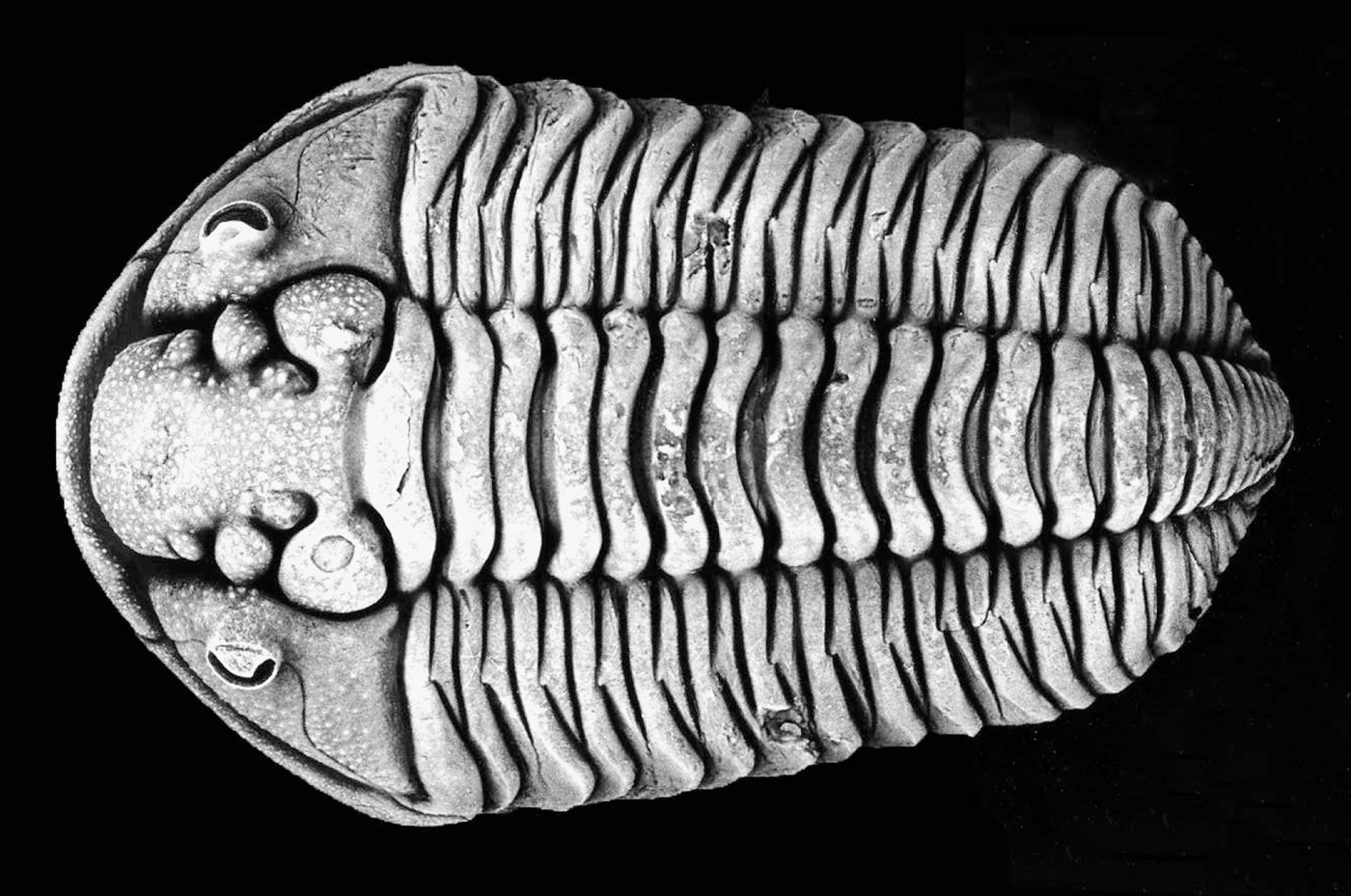
1. A Silurian trilobite, Calymene blumenbachii, from the limestone quarries of Dudley, West Midlands, England.
So a visit to Delaware is to me rather like a visit to the holy city of Rome to a Catholic. Naturally, I had to meet the Pope. The Pontiff of horseshoe crabs is Carl Shuster, in his tenth decade still a giant of a man: craggy faced, walking without the aid of a stick, with lively eyes beneath towering eyebrows, memory and curiosity undimmed, and only betraying his years by his deafness. Like all field biologists he wears a coarsely chequered thick shirt and blue jeans, hitched up with a stout belt. He was brought up during the Great Depression, when he had to run a farm, so he is himself a survivor, like the horseshoe crabs to which he has devoted his life. His father was a mathematician who gave succour to penniless intellectuals during the tough years, while young Carl raised asparagus, chickens and strawberries. He brought together all the current knowledge about his favourite animal in his book The American Horseshoe Crab. He is accompanied in Delaware by his former student, a man of boundless enthusiasm, Glenn Gauvry (himself an implausibly youthful sixty years), who coordinates much of the research on Limulus around the Bay area. Those volunteers who help with counting the crabs during their nocturnal orgies receive a handsome little pewter lapel pin as a record of their collaboration in the conservation project. Naturally, the pin features a horseshoe crab. It signifies membership of one of the more exclusive clubs in the world.
Carl Shuster and his colleagues established the biological facts about horseshoe crabs that allow naturalists to understand how they fit into the ecology of the Atlantic coast. Limulus is a typical arthropod in that it must moult in order to grow, shedding its old coat as a kind of pale ghost of its former self, and growing a new and larger external covering. With a little vigilance it is possible to find one of the cast ‘shells’ on the beach: they are almost as light as tissue paper, for the animal recycles what it can. The newly emerged horseshoe crab is capable of moving immediately. In this it has the advantage over other marine arthropods in the area; freshly moulted blue crabs, for example, are virtually motionless until their new ‘shell’ hardens. They often hide away. Younger horseshoes resemble the older ones apart from being a little spinier. The surprisingly tough, but flexible exoskeleton is made of a chitinous material, similar to that forming the wings of beetles. A typical horseshoe crab takes ten years to reach sexual maturity, after which it does not moult again, but heads to the beach for reproduction. Only these mature animals partake in the littoral orgy, which is why one does not see any little limulids scuttling between the adults. They are not demanding animals: a fully mature animal might go for months without eating. When her time comes, a female may well lay 80–100,000 eggs, and enough of these survive the depredations of wading birds to secure the future generations. The greenish eggs are laid in the sand in batches of four to six thousand in spheres about the size of a golf ball; the female makes repeated visits on successive tides to complete her duties. Females can be recognised by the scars left behind by the mounting males: up to fifteen males may have a chance of fertilising the eggs of any female. Nonetheless, only about thirty-three eggs out of a million survive to adulthood. This means that at various stages of its life Limulus provides a lot of food for other animals. Loggerhead turtles are an important predator on the crabs, even when they are adults. Turtles, too, are animals with a long geological history, so they may have had eons to make something nutritious out of horseshoe crabs, which now seem all sinew and horn and little enough meat. The crabs themselves can survive on molluscs and carrion and almost any kind of scraps, but the strong inner parts of the legs can also crush thick shells if needs be. Although they seem to lurch in an ungainly way on land, under water the crabs are more streamlined and can move quite fast, even sculling on their backs. They can easily right themselves if they need to. In short, they are tough, jack-of-all-trades kind of creatures, built to last. They remind me in a way of a Volkswagen Beetle that I once owned (a beetle being another arthropod, of course) that carried on carrying on even though its coach-work was full of rusty holes, its suspension was down almost to the tarmac, and it often fired on only three cylinders.




